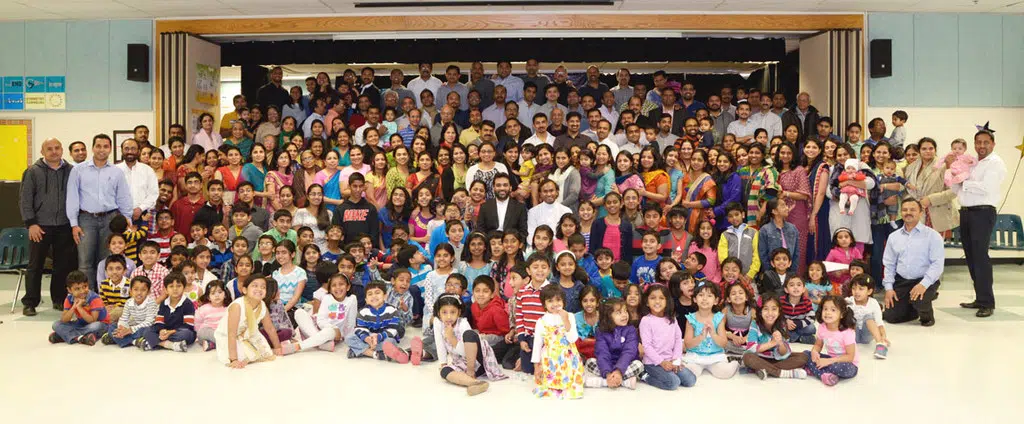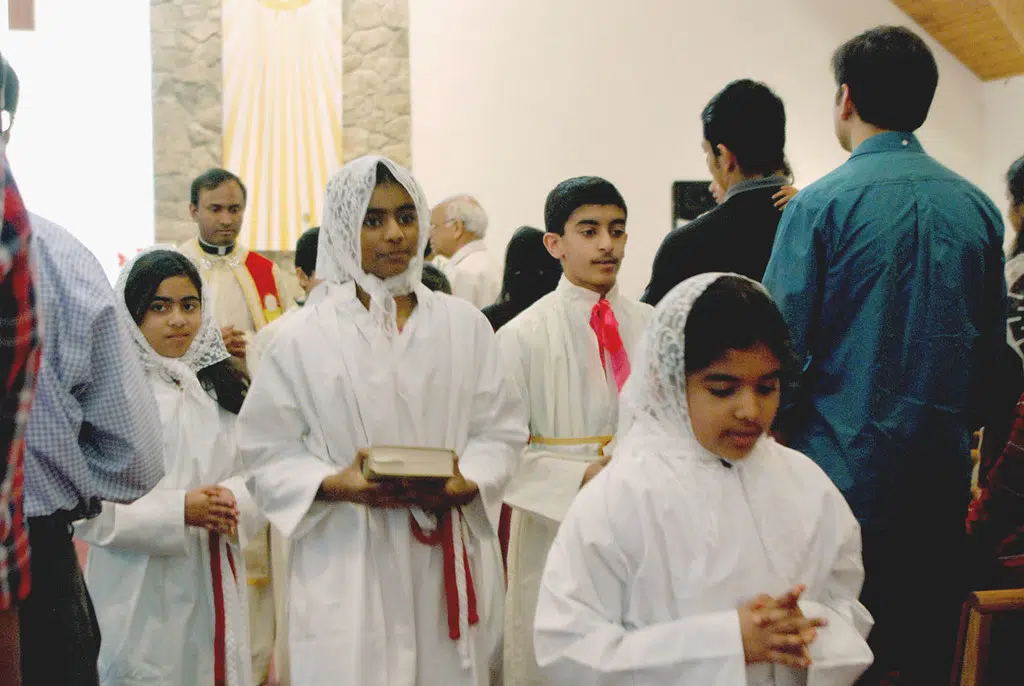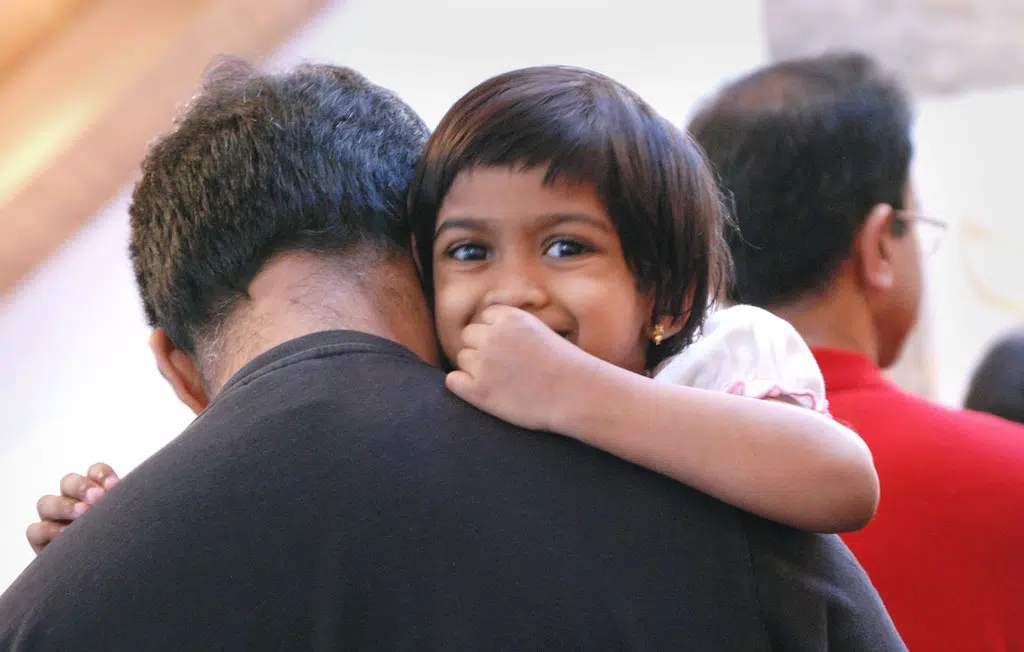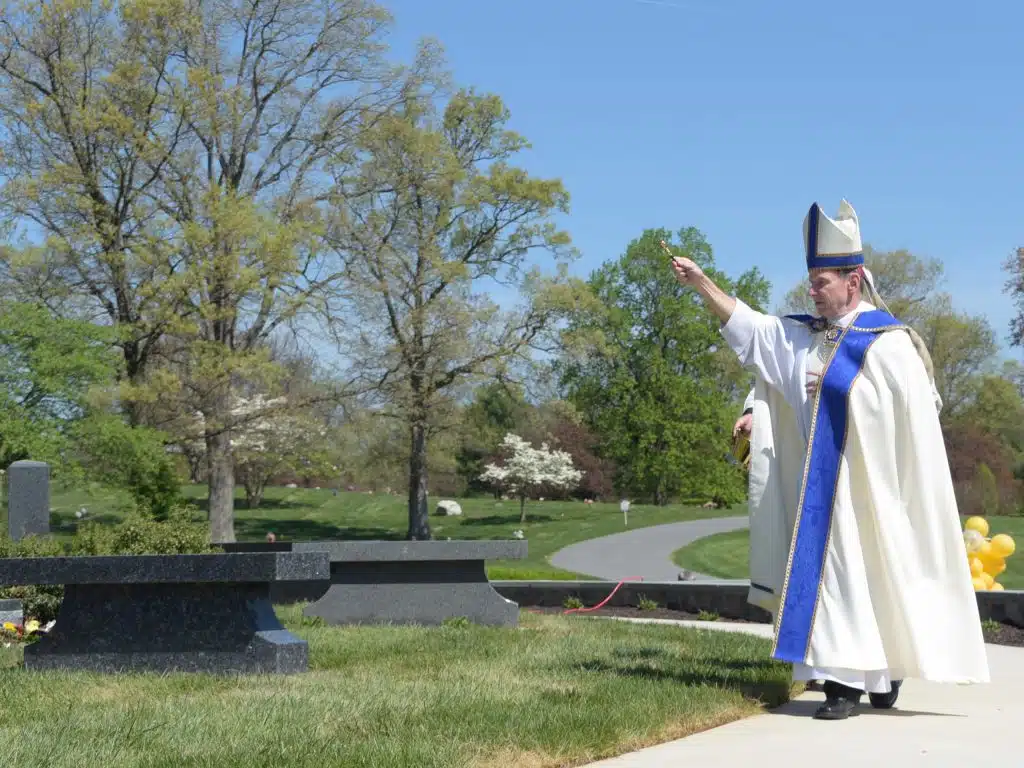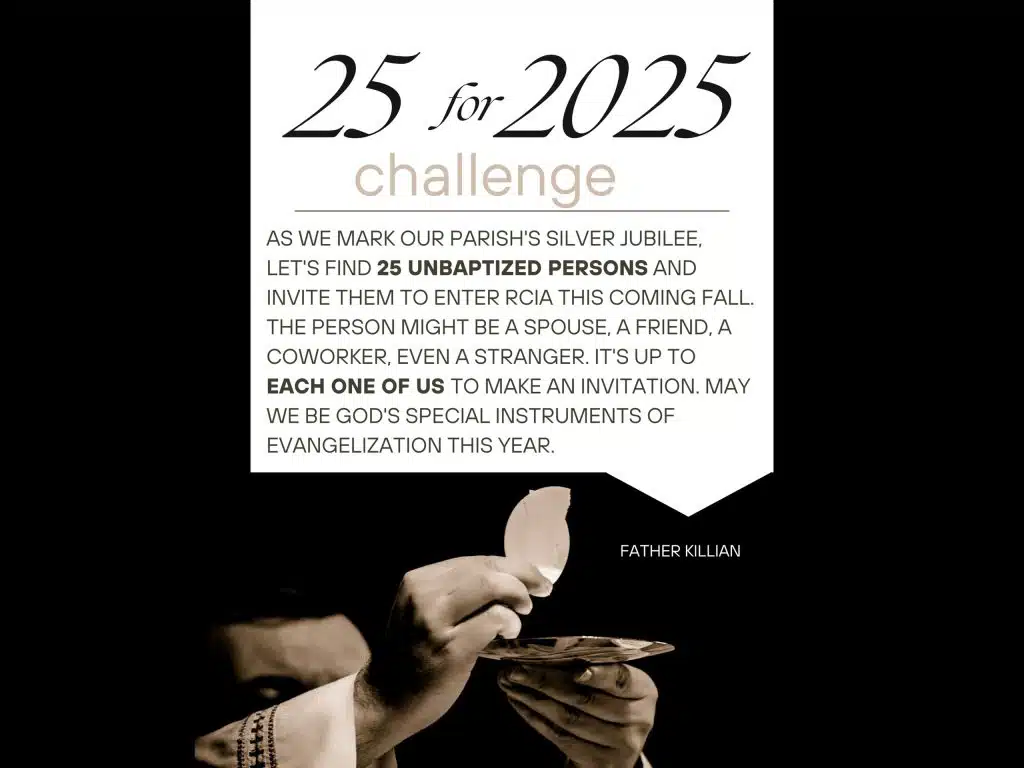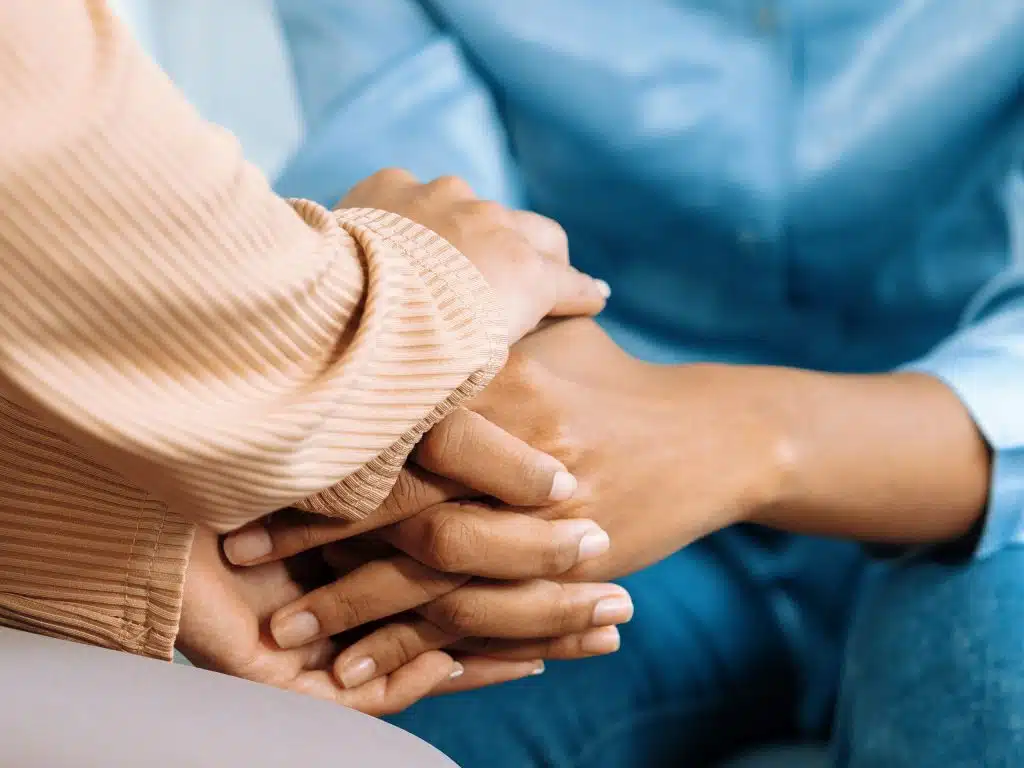When you see women wearing saris at a Catholic Mass, you might think they are visiting with Catholic friends. But on a sunny April afternoon at St. Andrew Lutheran Church in Centreville, families filling the pews were Catholics, not Hindus.
“You are a beloved one of God,” said Father Tijo Joy Mullakkara, a Syro-Malabar Catholic priest, during the bilingual youth Mass the Indian community organizes every month or so.
Throughout his homily, Father Tijo addressed the children, asking them questions about David and Goliath. About a dozen altar boys and so-called Altar Angels (young girls who take charge of distributing hymnals and arranging flowers) were just a few of the many little ones who shouted out their answers.
Pastor of St. Jude Syro-Malabar Mission in Centreville, part of the St. Thomas Syro-Malabar Diocese of Chicago, Father Tijo shepherds 120 registered families in Northern Virginia and 40 in Richmond. Though the community has gathered since 2006, it was not recognized officially until 2011 when St. Jude Mission was formed.
Headed by Bishop Mar Jacob Angadiath, the St. Thomas Syro-Malabar Diocese of Chicago was established by St. John Paul II in March 2001 and includes more than 30 parishes in the United States and Canada.
Founded by the apostle Thomas in South India around 52 A.D., according to the St. Thomas Diocese website, the Syro-Malabar Church is the second largest of the Eastern Catholic churches. Today, there are about 3.8 million Syro-Malabar Catholics around the world.
Corinne Monogue, director of the diocesan Office of Multicultural Affairs, said that most of Northern Virginia’s Indian Catholics are Syro-Malabar rite, but there are also Roman and, to a lesser extent, Syro-Malankara rite Indian Catholics.
“Bishop Loverde has given permission for this Epiparchy (and its bishop) to establish a parish,” said Monogue. “They are a different rite than our diocese … We post (their Mass) on our webpage, as we (get) lots of questions (about the availability of this rite in our diocese).”
And, for now, the group worships at St. Andrew Lutheran Church.
Dennis Hagstrom, pastor of St. Andrew Lutheran Church, said that his church’s relationship with the Syro-Malabar community is “very simple.”
“On Sunday afternoons, St. Jude uses our sanctuary, fellowship hall and some classrooms for Mass and Christian Education,” said Hagstrom. “They also use our education wing for a week of vacation bible school in the summer. In return, they are happy to offer us a monthly financial donation. There is also a friendly exchange of information when needed.”
Christianity in India
On the morning of April 16, a fiberglass statue of the Blessed Mother at St. Mary’s Church in Agra, India, was found wearing a dog leash. Another statue had been smashed, a car broken into, and the church doors nearly forced open. Agra, a city in northern India, is the site of the Taj Mahal, a grand mausoleum reverently known as “the jewel of Muslim art in India.”
According to the Indian Christian Activist Network, since December, at least six of Delhi’s churches have been vandalized. A rash of seemingly anti-Christian hate crimes included the rape of a 71-year-old nun last month.
Speculation over the motives behind this violence varies. Last month, retired police officer, Julio Ribeiro, wrote a column in The Indian Express, a national newspaper, stating he “felt threatened, not wanted, reduced to a stranger” in his own country because he is Christian.
Others, such as Delhi University professor Bharat Gupt, believe “persecution” is not the appropriate word for recent attacks against Christians because Indians are “accepted and treated with equality.” He claims that “Indian and British media has been misreporting and fudging the facts” because political parties want Christian votes. He said Christians’ rights to open institutions “free from government interference or supervision” are guaranteed and, in part, government-funded, under Article 30 of the Indian Constitution because they are a religious minority.
Father Tijo estimates that, though about 2 percent of Indians are Christian, about 20 percent of the country’s social and charitable institutions, from orphanages to homes for the elderly, are run by Christian organizations.
According to Father Tijo, though Portuguese explorers came to India in the 15th century for trade purposes, it was not until the arrival of the British in the early 1600s that Christianity was viewed by some as an “invasion” because of colonization.
“Even now in some places in India, people don’t want to speak English because of England,” said Father Tijo.
The irony is that Christianity hit India before it did England, as Sumit Sarkar points out in his 2007 essay, “Christian Conversions and Secularism,” published in Duke University’s book, The Crisis of Secularism in India: “… the origins of Christianity in one part of India (Kerala and Tamilnadu) go back to the early centuries of the Common Era, preceding, incidentally, the conversion of England to Christianity and indeed the formation of most living forms of Hindu traditions.”
Cassandra Collins, a non-denominational Christian who did a weeklong mission in India through an ecumenical organization earlier this year, observed that Indian Christians do not openly evangelize Muslims and Hindus the way American missionaries do.
“If someone is ethnically Christian in India,” she said, “it is generally accepted that they will be Christian, even if it’s in name only. What is unacceptable to many, though, is any attempt by Christians to convert Muslims, Hindus or Buddhists. Religion is viewed as central to culture and identity. To change religion is to reject one’s family, one’s heritage, almost the entirety of who one is in exchange for something foreign.”
Collins, who is from Newport News, said that she met one newlywed Christian couple – converts from Hinduism- who had gone through with a Hindu wedding because of family expectations but planned on holding a private Christian ceremony a month or two later.
“Christians are definitely in the minority in Northern India,” Collins said. “And Jesus seems, for many, but one option among many other gods. It is offensive to suggest (to non-Christians) that one God is the best, the only, option for all of humanity and that He can be reached through Jesus Christ.”
“While the Hindu is comfortable and satisfied with inherited religion, or svadharma, the Christian practice recommends, and for some denominations demands, proselytizing à la (the evangelical nonprofit) Joshua project,” Gupt said.
Father Tijo said much of the violence – “persecution” or otherwise – occurs against evangelical Christians, including American and European missionaries, rather than heritage Christians, such as the Syro-Malabar Catholics in southern India.
“Muslims react most violently to Christian missionaries in India and do not allow any change of faith,” said Gupt. “Islam is a proselytizing religion and does not allow competition.”
Father Tijo said that, despite recent attacks, “In general, Indian people (of any religion) are welcoming.”
Yet misunderstandings remain.
Hindu-Catholic dialogue
Arlington’s Father Donald Rooney, director of the diocesan Office of Ecumenical and Interreligious Affairs, is co-organizing a talk between Catholic and Hindu thought leaders at Durga Hindu Temple in Fairfax Station next month.
The May 23 talk, “Hindu and Catholic Traditions: Theological Reasons for Mutual Respect and Reverence,” will feature three Catholic speakers and three Hindu ones: Cardinal Jean-Louis Tauran, president of the Pontifical Council for Interreligious Dialogue; Arlington’s Bishop Paul S. Loverde; Francis X. Clooney, Parkman Professor of Divinity and director of the Center for the Study of World Religions at Harvard University; Anantanand Rambachan, professor of religion, philosophy and Asian studies at St. Olaf College in Minnesota; Abhaya Asthana, president of Vishwa Hindu Parishad of America; and Anuttama Dasa, chairman of the ISKCON Governing Body Commission.
The future of St. Jude Mission
One of St. Jude Mission’s main goals is to pass the faith and traditions on to the community’s children.
“It’s not easy to start a community with 100 families, but people are committed,” said Father Tijo.
One of the biggest challenges is that “the children are American, not Indian.”
“When they grow up, they feel American,” said Father Tijo. “How can we bridge the gap?”
One solution has been making the faith accessible in English, while still teaching the language – Malayalam – long part of the church’s history and customs.
New York-based Father Joseph J. Palackal, founder of the Christian Musicological Society of India, recently translated many Syro-Malabar educational and liturgical materials into English.
Another solution has been teaching songs, dances and other forms of cultural expression central to Syro-Malabar Catholic worship. The community will hold a family day at J. Michael Lunsford Middle School in Chantilly May 2 from 4 p.m. to 10 p.m. to showcase a few of the performances the children have learned, as well as other aspects of the faith and culture.
But a more concrete way of passing on the faith requires building a parish in Northern Virginia.
Jophy Jose, one of the community’s first members, said that worshipping at St. Andrew Lutheran Church has prevented St. Jude Mission from worshipping as they would in India. Logistics prevent them from adorning the altar according to their traditions. Syro-Malabar churches in India have curtains that separate the celebrant from the congregation. The curtains are opened and closed at different points during the Mass.
“The churches built by the British in India are old and beautiful,” said Jose. “They’re painted and very ornate, but we’re not sure if we will be able to get that done here (in Northern Virginia).”
“We haven’t bought a place yet because we are still raising funds,” said Father Tijo. “So pray for us.”
Find out more
To learn more about the St. Thomas Syro-Malabar Catholic Diocese of Chicago, go to stthomasdiocese.org. To learn more about “Hindu and Catholic Traditions: Theological Reasons for Mutual Respect and Reverence,” call Sant Gupta at 703/980-7487 or email [email protected].
Stoddard can be reached at [email protected].
